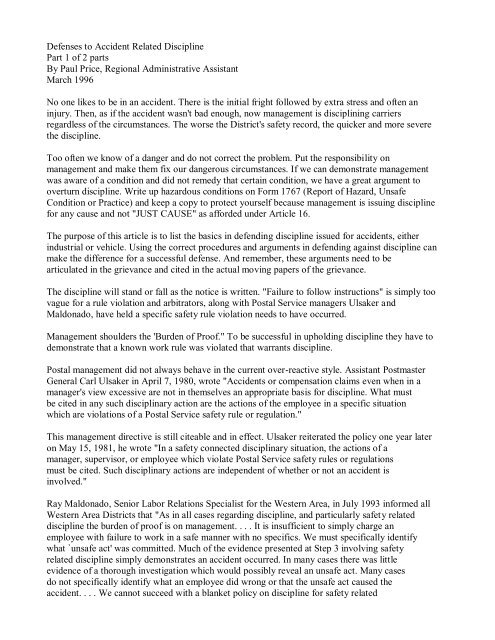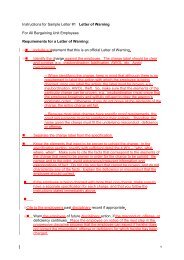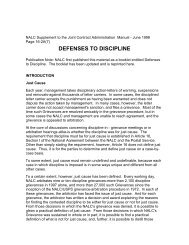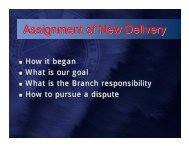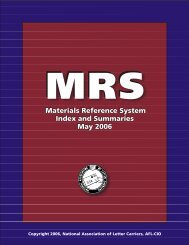Defenses to Accident Related Discipline - steward resources
Defenses to Accident Related Discipline - steward resources
Defenses to Accident Related Discipline - steward resources
- No tags were found...
You also want an ePaper? Increase the reach of your titles
YUMPU automatically turns print PDFs into web optimized ePapers that Google loves.
<strong>Defenses</strong> <strong>to</strong> <strong>Accident</strong> <strong>Related</strong> <strong>Discipline</strong>Part 1 of 2 partsBy Paul Price, Regional Administrative AssistantMarch 1996No one likes <strong>to</strong> be in an accident. There is the initial fright followed by extra stress and often aninjury. Then, as if the accident wasn't bad enough, now management is disciplining carriersregardless of the circumstances. The worse the District's safety record, the quicker and more severethe discipline.Too often we know of a danger and do not correct the problem. Put the responsibility onmanagement and make them fix our dangerous circumstances. If we can demonstrate managementwas aware of a condition and did not remedy that certain condition, we have a great argument <strong>to</strong>overturn discipline. Write up hazardous conditions on Form 1767 (Report of Hazard, UnsafeCondition or Practice) and keep a copy <strong>to</strong> protect yourself because management is issuing disciplinefor any cause and not "JUST CAUSE" as afforded under Article 16.The purpose of this article is <strong>to</strong> list the basics in defending discipline issued for accidents, eitherindustrial or vehicle. Using the correct procedures and arguments in defending against discipline canmake the difference for a successful defense. And remember, these arguments need <strong>to</strong> bearticulated in the grievance and cited in the actual moving papers of the grievance.The discipline will stand or fall as the notice is written. "Failure <strong>to</strong> follow instructions" is simply <strong>to</strong>ovague for a rule violation and arbitra<strong>to</strong>rs, along with Postal Service managers Ulsaker andMaldonado, have held a specific safety rule violation needs <strong>to</strong> have occurred.Management shoulders the 'Burden of Proof." To be successful in upholding discipline they have <strong>to</strong>demonstrate that a known work rule was violated that warrants discipline.Postal management did not always behave in the current over-reactive style. Assistant PostmasterGeneral Carl Ulsaker in April 7, 1980, wrote "<strong>Accident</strong>s or compensation claims even when in amanager's view excessive are not in themselves an appropriate basis for discipline. What mustbe cited in any such disciplinary action are the actions of the employee in a specific situationwhich are violations of a Postal Service safety rule or regulation."This management directive is still citeable and in effect. Ulsaker reiterated the policy one year lateron May 15, 1981, he wrote "In a safety connected disciplinary situation, the actions of amanager, supervisor, or employee which violate Postal Service safety rules or regulationsmust be cited. Such disciplinary actions are independent of whether or not an accident isinvolved."Ray Maldonado, Senior Labor Relations Specialist for the Western Area, in July 1993 informed allWestern Area Districts that "As in all cases regarding discipline, and particularly safety relateddiscipline the burden of proof is on management. . . . It is insufficient <strong>to</strong> simply charge anemployee with failure <strong>to</strong> work in a safe manner with no specifics. We must specifically identifywhat `unsafe act' was committed. Much of the evidence presented at Step 3 involving safetyrelated discipline simply demonstrates an accident occurred. In many cases there was littleevidence of a thorough investigation which would possibly reveal an unsafe act. Many casesdo not specifically identify what an employee did wrong or that the unsafe act caused theaccident. . . . We cannot succeed with a blanket policy on discipline for safety related
infractions except for extremely serious acts of misconduct which may warrant removaldepending on the specific facts or circumstances. . . . Arbitration his<strong>to</strong>ry has taught us thatany disciplinary action demands the exercise of responsible judgment so that employees willnot be penalized out of proportion <strong>to</strong> the offense." . . . <strong>Discipline</strong> such as suspensions orremovals should only be requested after responsible determination has been made that a lesssevere penalty would not suffice."Maldonado also informs management that prior <strong>to</strong> discipline, the specific identification of an unsafeact which contributed <strong>to</strong> the accident needs <strong>to</strong> be found. He also points out <strong>to</strong> labor representativesthat they need <strong>to</strong> consider if an adequate or effective lesser penalty could be applied. Maldonadoorders that the clarity for which the employee was on notice of any safety rules violated needs <strong>to</strong> beapparent.He finalizes the letter by stating the obvious: "It is important <strong>to</strong> remember that we cannot chargean employee with working in an unsafe manner unless we can specifically identify an unsafeact."However, at the NBA's office, we still see discipline coming from the field that simply says that thegrievant was involved in an accident or they failed <strong>to</strong> be safe, or "failed <strong>to</strong> follow instructions," but nospecifics are ever identified. Failure <strong>to</strong> cite a specific rule infraction should be stressed early on in thesteps of any grievance. The following are the issues the Union should stress in our defence of thecase.CASE OUTLINE1. Did management show 'just cause' for their disciplinary action? Does the disciplinemeet the seven tests of `just cause'? If you are unfamiliar with the `just cause' criteriaplease do not hesitate <strong>to</strong> request this from your branch President or our office.2. Was a specific rule violated?3. Did the Service take mitigating fac<strong>to</strong>rs in<strong>to</strong> account or is discipline au<strong>to</strong>matic?4. Did management present clear evidence (proof) that the grievant acted in an unsafemanner?5. Did management investigate the accident properly and timely, was there adisciplinary investiga<strong>to</strong>ry interview?6. Was the discipline progressive, non disparate, and timely?7. Did management take the position that the grievant was a unsafe driver and revokegrievant's driving privileges?8. Did the service issue discipline <strong>to</strong> discourage accident reporting?9. Was remedial driver training conducted?10. Is the penalty punitive?
This is the first of a two part article and will deal with only items 1-5 from the points listed above.A. WHAT SPECIFIC RULE WAS VIOLATED? (The following are excerpts from ALERT:)C#08071, Sobel, "<strong>Discipline</strong> is appropriate only when an employee violates a safety rule or practice.Barring such a determination of rule violation discipline cannot be imposed under the just causestandard."C#12808, Baldovin, 1993, ". . . Throughout the processing of this grievance, at steps 2 & 3 thePostal Service refers <strong>to</strong> Grievant's inability <strong>to</strong> perform his duties in a safe accident free manner. Yet,Grievant has never been disciplined for violation of any safety rules, regulations or procedures."C#09594, Sobel, 1989, ". . . Four of the eleven accidents did not involved medical attention and thegrievant <strong>to</strong>ok no time off for his `injuries.' Had the grievant not conformed <strong>to</strong> instructions by reportingthe incidents . . . the Employer would not have been able even <strong>to</strong> enumerate them as accidents in itslitany."B. WAS A COMPLETE AND FAIR INVESTIGATION OF THE ACCIDENTCONDUCTED?Relevant handbooks and manuals incorporated through Article 19 of the National Agreement need <strong>to</strong>be reviewed and inconsistencies noted in the grievance. The question should always be asked, "Wasthere a complete investigation? EL 801, Supervisor's Safety Handbook, Section 232.3, obligatesmanagement <strong>to</strong> conduct a "complete report" as <strong>to</strong> who, what, where, when, how and why."Arbitra<strong>to</strong>rs agree with the EL 801, C#10785, Ea<strong>to</strong>n, 1991, "In not being interviewed prior <strong>to</strong> theissuance of the Removal Notice, the Grievant was deprived on his due process rights. . . .On the keycharge, Supervisor Jackson stated that he concluded that an unsafe act had occurred based simplyon the Grievant's past performance. . . . Postal Service regulations require that a specific act or rulebe cited as having been violated where discipline is assessed for a safety violation. . . . It isundisputed that the Grievant was injured. He was not injured as the result of an unsafe act, only as aresult of an unfortunate occurrence. . . ."EL 801, Section 250 lists "corrective measures" enforcement of safety rules (otherwise known asdiscipline) as the 6th option available <strong>to</strong> correct an unsafe act. The thorough <strong>steward</strong> will readChapter 1 and 2, along with Appendix A of the EL 801 <strong>to</strong> find management violations in reportingand correcting the problem.<strong>Accident</strong> Forms 1700, 1769, along with instructions, and SF 91, complete with Form 4586 need <strong>to</strong> bescrutinized for errors or a specific safety rule infraction. These forms should also be included insidethe grievance for our reference. If 3rd parties or property damage is involved, request Form SF95and 2198 along with Form 4564 or 4564A. The 1769, if filled out correctly sometimes points <strong>to</strong>mitigating fac<strong>to</strong>rs such as What was the weather like? questions 14; Lighting conditions, question 20;Road and surface conditions which might contribute are questions 21 and 22; Circumstances leading<strong>to</strong> or playing a part in the accident number 23-26; Any unsafe fac<strong>to</strong>rs or actions? question # 47 and48; Is a Safety analysis on file, question number 60; Preventative Action Code, question number 61lists 15 other corrective action besides discipline, why rely on only discipline?; The 1769 asks, underquestion # 8, if a on-site investigation was preformed.Form 1700 has spaces for narrative answers, what did the investigating officer find? Ice? Blockedvision? Other hazards noted? Possible vehicle malfunctions? All good defenses.
C. WAS THE ACCIDENT INVESTIGATION AND THE DISCIPLINARYINVESTIGATION COMPLETED TIMELY?The 1769 and other accident reports need <strong>to</strong> be completed in a certain time frame indicated on thereports themselves. If management fails <strong>to</strong> investigate or fill these forms out timely, how can theythen argue that the infraction was so egregious that discipline needs <strong>to</strong> be taken if managementwasn't serious enough <strong>to</strong> complete their reports correctly. In the grievance point out when theaccident and disciplinary investigation <strong>to</strong>ok place, Arbitra<strong>to</strong>rs have held <strong>to</strong> be accurate and fair theyboth should be conducted in a timely manner.C# 10785, Ea<strong>to</strong>n, 1991, "While the Postal Service arguesthat failure <strong>to</strong> conduct a timely and thorough investigation could not harm the Grievant in this dispute,the evidence is <strong>to</strong> the contrary. We cannot know exactly what the cause of the Grievant's reinjurywas for the reason that the matter was not investigated in a timely and thorough manner, and noaccurate determination was made while the facts were fresh and all participants present."Form 1769 on page one under "submission procedures" reads "The supervisor must complete thisform within 24 hours" and "The local office must retain a copy of all reports in that office for a5-year period." Please guarantee that the previously listed forms are included in each grievance.Handbook EL 827, Driver Selection Training, Testing and Licensing, (1989) is now replaced by theDrivers Selection Orientation Familiarization and Certificate Program (January 1993). However, westill want <strong>to</strong> argue that additional corrective training, as outlined in EL 827 Section 350 and 360, is the"corrective" approach and discipline is simply punitive and in violation of Article 16.Other articles violated that need <strong>to</strong> be listed in the grievance are Articles 3, 5, 14, 16, and 19.In my next article I will go in<strong>to</strong> depth on arbitration rationale <strong>to</strong> justify discipline for accidents, as wellas highlight case points 6-10.Prior <strong>to</strong> meeting with management at Step 1 or 2, the <strong>steward</strong> or Step 2 designee needs <strong>to</strong> review theALERT manual sent out by the NBA office. Specifically pages 314 through 338. This is the bestsource document for defending discipline based on accidents.If your branch does not have these pages of the ALERT, please request them from our office.
<strong>Defenses</strong> <strong>to</strong> <strong>Accident</strong> <strong>Related</strong> <strong>Discipline</strong>Part 2 of 2 Part ArticleBy Paul Price, Regional Administrative AssistantJune 1996In the March NBA Newsletter I wrote the first part of this two part article.The amount of discipline related <strong>to</strong> accidents is slightly lower thanks <strong>to</strong> the weather improving.However, the number of grievances received in our office is still unacceptably high. Thus the reasonfor this article.This type of discipline serves very little, if any, corrective purpose and simply applies more stress ona managers budget. Carriers and <strong>steward</strong>s are filing grievances and attending interviews instead ofdelivering mail, but we're paid by the hour so fill out your statements and grievance forms thoroughlyand correctly, as well as take enough time <strong>to</strong> avoid the accident in the first place.If discipline is issued, follow the case outline below:CASE OUTLINE1. Did management show `just cause' for their disciplinary action? Does the disciplinemeet the seven tests of `just cause'? If you are unfamiliar with the `just cause' criteriaplease do not hesitate <strong>to</strong> request this from your branch President or our office.2. Was a specific rule violated?3. Did the Service take mitigating fac<strong>to</strong>rs in<strong>to</strong> account or is discipline au<strong>to</strong>matic?4. Did management present clear evidence (proof) that the grievant acted in an unsafemanner?5. Did management investigate the accident properly and timely, was there adisciplinary investiga<strong>to</strong>ry interview?6. Was the discipline progressive, non disparate, and timely?7. Did management take the position that the grievant was an unsafe driver and revokegrievant's driving privileges?8. Did the service issue discipline <strong>to</strong> discourage accident reporting?9. Was remedial driver training conducted?10. Is the penalty punitive?In the March article I covered the first 5 elements listed above, in this article the last 5 will becovered. Keep these two thoughts in mind during the case preparation.#1 - in order <strong>to</strong> meet the just cause provisions any discipline must be corrective and notpunitive.
#2 - In order <strong>to</strong> justify discipline for an unsafe act, an unsafe act has <strong>to</strong> be specified.Ray Maldonado, Senior Labor Relations Specialist in a July 1993, letter said "It is important <strong>to</strong>remember that we (management) cannot charge an employee with working in an unsafemanner unless we can specifically identify an unsafe act."6. PROGRESSIVE, NON DISPARATE AND TIMELY DISCIPLINE.<strong>Discipline</strong> under just cause calls for the employee <strong>to</strong> be forewarned of the penalty for a safetyviolation.The forewarning normally comes by way of an official discussion with the employee. Managementshould have instructed the employee that under no uncertain terms that if they perform this particularinfraction they can be disciplined. The discipline will usually begin with a letter of warning.Further, similar violations call for a progression in discipline, i.e., a second LOW or shortsuspension, if violated again a longer suspension, and if violated again maybe a 30 day suspension orremoval. As Western Area Regional Arbitra<strong>to</strong>r Levak wrote in C#6299, "Another principleapplicable <strong>to</strong> this is that the degree of progressive discipline must be reasonable. . . For example, it isa reasonably well-established practice within the Western Region for a 7-day suspension <strong>to</strong> befollowed by no more than a 14-day, or at the most, a 30-day suspension. The arbitra<strong>to</strong>r knows of nogrounds upheld by Western Region arbitra<strong>to</strong>rs where a removal has followed a 7-day suspension."For progressive discipline <strong>to</strong> be implemented correctly the offenses have <strong>to</strong> be similar. Managementin this area attempts <strong>to</strong> list any misconduct under "Failure <strong>to</strong> Follow Instructions." While managementis required <strong>to</strong> identify a specific safety rule infraction they are also obligated <strong>to</strong> specify the offense.Arbitra<strong>to</strong>r Levak in C#6299 wrote, ". . . it must be remembered that some sort of connection canalways be established. For example, virtually every type of infraction within the Service is coveredby some handbook or manual. So the Service can always argue that the infraction is always related<strong>to</strong> a failure <strong>to</strong> follow instructions. Similarly, virtually every discipline act is the result of eitherintentional misfeasance or non-feasance (carelessness or negligence). So the Service can alwaysargue that every act of misfeasance is akin <strong>to</strong> a failure <strong>to</strong> follow instructions, and every act ofnonfeasance is the result of a safety violation, which in turn may be construed as a failure <strong>to</strong> followinstructions relating <strong>to</strong> safety. Such a general connection does not satisfy the last stated principle; aconnection between types of offenses must be more than remote."In non-disparate treatment, management must apply its rules and penalties evenly. Supervisor'sGuide <strong>to</strong> Handling Grievances EL 921 states, "If a rule is worthwhile, it is worth enforcing, but besure that it is applied fairly and without discrimination. Consistent and equitable enforcementis a critical fac<strong>to</strong>r, and claiming failure in this regard is one of the union's most successfuldefenses. The Postal Service has been overturned or reversed in some cases because of notconsistently and equitably enforcing the rules. Consistently overlooking employee infractionsand then disciplining without warning is one issue."Arbitra<strong>to</strong>rs have ruled the discipline needs <strong>to</strong> be issued timely so as <strong>to</strong> prove management'ssincerity and <strong>to</strong> demonstrate <strong>to</strong> the employee the Service is serious in correcting the employeesbehavior.
C#1261, Arbiter Schedler writes, ". . . In the usual grievance a delay in presenting charges can meanthe loss of evidence <strong>to</strong> an aggrieved. Memories fade with the passage of time, witnesses becomedifficult <strong>to</strong> locate so as <strong>to</strong> reconstruct the events in question. . . a delay in presenting chargesdamages an employee's right <strong>to</strong> prepare <strong>to</strong> defend himself against the charges and that is where Idisagree with the procedures the Employer followed."C#7106, Arbiter Howard writes, ". . .it is an essential aspect of industrial due process that disciplinebe administered reasonably prompt after commission of the offense which prompted the discipline. . .a delay in the imposition of discipline clearly leads the employee in<strong>to</strong> a false sense of security that hisconduct is acceptable <strong>to</strong> the Service. Thus, the corrective nature of the disciplinary process becomesunnecessarily blunted."7. DID MANAGEMENT REVOKE THE GRIEVANT'S DRIVING PRIVILEGES?All <strong>to</strong>o often a manager will suspend driving privileges for some unexplained reason (see #8 below)even after the grievant has finished their route or even driven for days after the accident. Why thenew heightened concern? Good argument! Arbitra<strong>to</strong>rs apply EL 827.Arbitra<strong>to</strong>r Rentfro in C#11901 states, "The Service has asserted that . . ., it determined that Grievantwas an unsafe driver and revoked her OF-346. However, the Arbitra<strong>to</strong>r finds that the evidencepresented by the Service is clearly inadequate <strong>to</strong> support its decision <strong>to</strong> revoke Grievant's license.The Service should have applied the criteria set out in Section 463.4 of the EL-827 <strong>to</strong> determinewhether or not revocation was appropriate under the circumstances."The EL 827 463.4 states, "Decisions <strong>to</strong> suspend or revoke driving privileges are made afterinvestigation and determination as <strong>to</strong> whether the driver was at fault (whether the driver's actionswere the primary cause of the accident), the driver's degree of error, past driving and disciplinerecords, and/or the severity of the accident. The quality or absence of prior training in a particulardriving activity should be considered as well, and the employee's inability <strong>to</strong> meet USPS physicalstandards at the time of an accident is also a fac<strong>to</strong>r <strong>to</strong> be considered."8. DID THE SERVICE DISCIPLINE TO DISCOURAGE THE FILING OF ANACCIDENT REPORT OR CLAIM?The answer <strong>to</strong> this is "almost every time." Everyone needs <strong>to</strong> remember supervisors, managers,postmasters and Districts as well as the Area are graded on the number of accidents under its ortheir control. Because of the new cluster ratings or supervisor pay rate, the discouragement ofaccidents (or reports) will only increase. Find your units and District's ratings or rankings and arguethis point. While supervisors don't care, an arbitra<strong>to</strong>r will. Please include flash reports, etc.9. WAS REMEDIAL (OR CORRECTIVE) TRAINING CONDUCTED? THE EL 827SECTION 350 AND 360 REQUIRES REMEDIAL TRAINING FOR EACHPREVENTABLE ACCIDENT.EL 827 350 "Refresher Driving Training." Refresher driver training is strongly encouraged for alllicensed drivers. . . The refresher driver training may be mandated by the Division or by the localMSC. Such training may be provided on an as-needed basis.EL 827 360. Improvement Driver Training. All drivers (including rural carriers and rural carrierreliefs) must receive improvement driver training following a preventable vehicle accident . . . or,
when warranted, based on observations of driving practices that are in need of improvement. . . Tobe most effective, improvement driver raining should be within 10 calendar days of the accident orobservation of unsafe driving habit since the events of the occurrence will be more accuratelyremembered by the driver.EL 801 also encourages corrective remedial training. Always argue the Service is acting in a punitivenature if they go right <strong>to</strong> discipline instead of training - after all everyone could use refresher trainingbut be forewarned training is budget inhibitive.10. WAS THE DISCIPLINE ACTION PUNITIVE?We discussed progression under point #6, and progressive and punitive are related. The requiremen<strong>to</strong>f Article 16 for discipline not <strong>to</strong> be punitive calls for the punishment <strong>to</strong> fit the crime.Does a mailbox lid that springs open warrant a suspension? Absolutely not! And if it does, the safeand prudent carrier will follow management's alleged safety concern. Write those boxes up! Eachand every one. Put management on written verifiable notice with 1767s or 8143s, that the box isunsafe or does not meet box regulation requirements listed in Postal Bulletin 4/27/95.Take the time <strong>to</strong> write those boxes up because if you don't you might be losing one <strong>to</strong> two weeks ofpay. Management will argue you deserve the discipline because you're paid <strong>to</strong> be safe and paid <strong>to</strong>write hazards up.<strong>Discipline</strong> for safety related accidents is on the rise - cover yourself and teach every carrier <strong>to</strong> do thesame.Management can't have it both ways. It's either management pay raise initiated speed ormanagement pay raise required safety. And remember, failure <strong>to</strong> abide by every normal safetyprecaution may cost you your paycheck.<strong>Discipline</strong> is on the rise so be careful, and apply these basics in defending safety related discipline.


